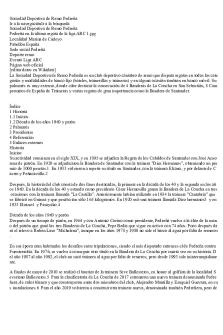SODA LIME Reviewer - notes PDF

| Title | SODA LIME Reviewer - notes |
|---|---|
| Author | Shen Via |
| Course | Medical Laboratory Science |
| Institution | San Pedro College |
| Pages | 2 |
| File Size | 40 KB |
| File Type | |
| Total Downloads | 76 |
| Total Views | 128 |
Summary
notes...
Description
**********THIS PART IS FROM FIRST SOURCE C. ) Soda-Lime Test Specific Objective: To determine the change in color of the moistened red and blue litmus paper when exposed to the vapor of the heated mixture of Soda-lime and Residue B. To determine whether the mixture is an acid or a base by noting the change in color of the litmus paper. OBSERVATIONS When the moistened litmus papers placed at the tip of the stirring rod were exposed to the vapor of the heated mixture of Soda-lime and Residue B, changes in color occurred. The red litmus paper turned into blue while the blue litmus paper didn’t change at all and retained its blue color. Purpose: To determine whether the mixture is basic or acidic Additional Information: Soda lime contains 94% Calcium hydroxide and 5% sodium hydroxide with 1% potassium hydroxide. It absorbs carbon dioxide in the presence of water vapour or moisture. Why must the litmus papers be moistened first before exposing them to the fume/vapor evolved during the heating? The litmus papers are moistened to absorb the vapor of the mixture and through this; we’ll be able to take note of the changes in color of the litmus papers. **********************THIS PART IS FROM ANOTHER SOURCE PERO MAS MAINTINDIHAN SODA LIME TEST OBJECTIVE: To determine if the sample is acidic or basic with the use of soda lime Positive Result: The litmus paper will undergo a change in color. Reagent: Soda Lime Procedure:
Grind a pinch of Soda lime and a portion of residue B. Transfer the mixture in a dry test tube and heat gently over the flame. After a minute of heating, test the vapor by placing pieces of moistened red and blue litmus paper at the tip of the stirring rod. Note the change in color of the pieces of litmus paper.
Blue litmus paper changes its color to red when the mixture is acidic, and the red litmus paper turns blue when the mixture is basic or alkaline. Principle of the test: The principle involved is deamination, which is a process where the amino acid loses its amine group. This test detects N- containing lipids or amino groups. Purpose of the reagent: The soda lime absorbs the CO2 and H2O vapor in order to detect the N- containing lipids. The Soda lime test detects the lipid group sphingolipids which are found in the cell membranes of the brain and nervous tissue.
**********PPT NOTES FIRST SLIDE: INTRO SECOND SLIDE: OBJECTIVE – BASAHA TAPOS INGNA NA “The Soda lime test also detects the lipid group sphingolipids which are found in the cell membranes of the brain and nervous tissues.” THIRD SLIDE: READ THEN ADDITIONAL INFO
Blue litmus paper changes its color to red when the mixture is acidic, and the red litmus paper turns blue when the mixture is basic or alkaline. Additional Information: Soda lime contains 94% Calcium hydroxide and 5% sodium hydroxide with 1% potassium hydroxide. The litmus papers are moistened to absorb the vapor of the mixture and through this; we’ll be able to take note of the changes in color of the litmus papers.
DEAMINATION - The principle involved is deamination, which is a process where the amino acid loses its amine group. This test detects N- containing lipids or amino groups. NH4OH is the compound that is responsible for the change of color of the litmus paper. NH3 + H20 = NH4OH(vapor)...
Similar Free PDFs

SODA LIME Reviewer - notes
- 2 Pages

Selz Soda - Lecture notes 1
- 10 Pages

Soda PDF-converted-La Profesa
- 4 Pages

Soda PDF-converted-remo pedreña
- 4 Pages

Lab4Analysis of Soda Ash
- 7 Pages

Soda PDF-converted-neutron
- 3 Pages

Soda Stream-Project 21
- 8 Pages

Midterm reviewer - Notes
- 57 Pages

D Silytc Notes + Reviewer
- 9 Pages

Coconut Key Lime Crinkle Cookies
- 1 Pages

OM- Reviewer - Notes
- 4 Pages

Travel Agency - NOTES/REVIEWER
- 18 Pages
Popular Institutions
- Tinajero National High School - Annex
- Politeknik Caltex Riau
- Yokohama City University
- SGT University
- University of Al-Qadisiyah
- Divine Word College of Vigan
- Techniek College Rotterdam
- Universidade de Santiago
- Universiti Teknologi MARA Cawangan Johor Kampus Pasir Gudang
- Poltekkes Kemenkes Yogyakarta
- Baguio City National High School
- Colegio san marcos
- preparatoria uno
- Centro de Bachillerato Tecnológico Industrial y de Servicios No. 107
- Dalian Maritime University
- Quang Trung Secondary School
- Colegio Tecnológico en Informática
- Corporación Regional de Educación Superior
- Grupo CEDVA
- Dar Al Uloom University
- Centro de Estudios Preuniversitarios de la Universidad Nacional de Ingeniería
- 上智大学
- Aakash International School, Nuna Majara
- San Felipe Neri Catholic School
- Kang Chiao International School - New Taipei City
- Misamis Occidental National High School
- Institución Educativa Escuela Normal Juan Ladrilleros
- Kolehiyo ng Pantukan
- Batanes State College
- Instituto Continental
- Sekolah Menengah Kejuruan Kesehatan Kaltara (Tarakan)
- Colegio de La Inmaculada Concepcion - Cebu



